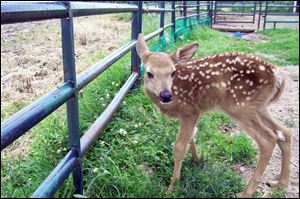
Fawn's fate is best left to Mother Nature
6/8/2010
After its 'rescue' by a Toledo police sergeant, a fawn escaped an enclosure before it could be confiscated by Ohio wildlife officers.
Two sayings about life and living of which my late Mom was fond apply very well in the save-the-fawn case, about which so much has been made in recent days.
When the heart fills, the head empties. And the road to hell is paved with good intentions. They apply in this much-heralded tale:
A Toledo policeman comes upon a white-tailed deer, a pregnant doe at that, which lies dying after being clipped by a passing car. The lawman ends up reviving one of two fawns the doe had been carrying, and takes it home to "rescue" it.
In the end the fawn magically escapes the clutches of the Ohio Division of Wildlife [the big bad wolf in this fairy tale] by bursting from captivity through a porch screen. Presumably it will live happily ever after. Uh huh.
The People for Ethical Treatment of Animals certainly would have you believe so. They commended the policeman for his well-intended (if ill-conceived) intervention.
Truth is, that fawn stands little chance of surviving on its own. Only in the world of Disney would an orphaned Bambi be adopted by a doe "stepmother." Documented cases of such fawn adoption are painfully low.
Too, this "born-free" fawn is not even three weeks old, if it is alive at all today, so it remains dependent on milk, preferably doe milk, to keep from starving, let alone growing and thriving. It cannot survive on vegetation alone till it is 10 or 12 weeks old. And, as an orphan, it will have no whitetail role-model to teach it the ropes "out there." Humans make lousy role-models for wild creatures.
Chances are, this much-heralded fawn will become dinner for a coyote or maybe a stray dog. Or it will itself be road-killed or catch a fatal disease. Sometimes whitetail does themselves are known to abandon their own fawns to the fates of the wild. That is the reality of the road to hell. It's a jungle out there.
Even when "rescued," most fawns released after rehabilitation soon die. Those that survive generally do so around human dwellings where they may create nuisance and public safety concerns.
About 300,000 fawns are born in Ohio every year. About 150,000 of them never get past their first autumn. These are the kinds of facts - rather than ill-conceived, touchy-feelly notions - that wildlife biologists and deer managers must address.
Indeed, if most fawns survived, we would be even more inundated with white-tailed deer than we are today. Ohio hunters have been killing and eating a quarter of a million deer a year in recent years under unbelievably liberal hunting bags, and that is just starting to make a difference in deer-herd growth. More needs to be done, and state deer managers know it.
Last year the Ohio Division of Wildlife set a policy, in cooperation with the Ohio Wildlife Rehabilitators Association, to help reduce possible spread of deadly chronic wasting disease, or CWD, in deer. It is not found in Ohio so far, and everything that can be done to keep it that way is worth doing. So there is no rehab of fawns, or injured deer of any sort.
The policy states further that any fawns picked up from dead does should be released in the same township in which they are found, in an area where they might, just might, be adopted by other does.
If, in the save-the-fawn case, the state wildlife division allows an exception, then the exception invariably will become the rule. That is why wildlife lawmen wanted the resuscitated fawn released and to let nature take its inevitable course.
Wildlife rehabilitaters, by the way, do a wonderful job. But they are up to their eyeballs in all manner of rare and perhaps endangered species to rehabilitate and they operate on a shoestring. They have neither time nor staff to spend on rehabbing animals that are prolific and abundant, such as deer, raccoons, rabbits, house sparrow, and robin nestlings, or other common creatures.
As for do-it-yourself wildlife rearing, just what, exactly, do you really know about a given creature's needs? Few of us know much of anything, other than guessing. That is why we turn to certified rehabilitaters in appropriate cases.
Yes, it is hard to witness a wildlife death, especially when it is a young animal. We humans immediately want to project, to enter the fantasy that we are seeing the loss of a "baby," a human baby. But nature has no feelings, no emotions, no morals, and animals have no knowledge or concept of death and dying. Projecting human thoughts and feelings and sensibilities on animals does them a disservice, does not respect them for what they are. We need to understand that, and accept it.
If this save-the-fawn case eventually manages to generate some light - the light of reason - in the public mind rather than heat, the heat of mindless emotion, then maybe it will have a satisfactory ending.
But if all it does is reinforce nonsensical notions, it is not worth the paper that PETA commendation is printed on.
Contact Steve Pollick at:
spollick@theblade.com
or 419-724-6068.